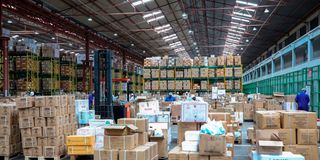Bid to stop theft of drugs in public hospitals

A section of the Kenya Medical Supplies Authority Embakasi Depot, Nairobi County on May 18, 2023.
What you need to know:
- This year several counties including Nairobi, Murang’a, Nyandarua, Siaya, Homabay, Kiambu and Kisii have reported incidents of drug theft in public hospitals, with governors vowing to tighten tracking systems for medical supplies.
- In Nairobi, three suspects were found early this year in a van transporting drugs believed to have been stolen from public hospitals while in Murang’a, four workers were arrested while loading drugs worth Sh1.5 million in a private car.
When Newton Mwirigi was rushed to Meru Teaching and Referral Hospital in July last year with a deep cut, he hoped to get all services under one roof.
But this was not to be because when he presented his prescription to the hospital pharmacy, only half of the prescribed medicines were available at the county’s top public hospital.
“I spent more than Sh3, 000 to buy drugs in chemists. This was expensive for me,” Mr Mwirigi says.
Due to perennial stock-outs, Mr Mwirigi is among thousands of patients who have to bear the out-of-pocket cost of drugs and non-pharmaceuticals whenever they visit public hospitals.
A spot check by Healthy Nation established that there are four private chemists a few steps from the Meru Teaching and Referral Hospital main gate that meet the ever-present need for patients to buy drugs.
For the last one month, Meru Governor Kawira Mwangaza has been on a mission to curb theft and shortage of drugs and non-pharmaceuticals in public hospitals.
When the county received its latest consignment of medical supplies worth Sh50 million from the Kenya Medical Supplies Authority in June, the governor ordered a physical count of every item.
She also directed that all supplies be delivered to a warehouse in Meru town for verification before being distributed to the county’s 230 facilities.
A monitoring team has been visiting every hospital to track the use of drugs in efforts to stop the theft.
“Our hospitals have been branded ‘Kagure’ (go and buy drugs) because of an unending shortage. This is despite the county procuring drugs worth millions of shillings. Some hospitals have been going for months without drugs yet trucks are flagged off every quarter. Going forward, I will no longer flag off trucks without verifying what is inside the box,” Governor Mwangaza said.
According to the governor, the perennial shortage of drugs and non-pharmaceutical supplies in public hospitals remains an impediment to delivery of quality healthcare.
“By centralising the distribution of medical supplies, we intend to instil confidence in the community by maintaining a high level of transparency and accountability,” Ms Mwangaza said.
A hospital manager in Meru who spoke to Healthy Nation anonymously said theft of drugs and non-medical items is a big challenge, particularly in big hospitals.
“As hospital managers, we have to remain vigilant because of theft. There are cases of workers hiding items in their clothes and bags. This is why close monitoring of CCTV and frequent inspections are very critical,” the official said.
Pharmacists say continued use of manual systems for tracking drugs is a gaping loophole in efficient management of public hospitals.
According to Dr Eric Mutunga, the Meru Teaching and Referral hospital supply chain pharmacist, they use physical bin cards to track inventory levels.
“There is an urgent need for the county to invest in a health information management system that can track inventory in the stores and pharmacy. This will eliminate data quality issues and make it easy to monitor stock outs,” Dr Mutunga said.
He, however, noted that enhanced security measures on drugs supplied by Kemsa had led to a decline in theft cases in public hospitals.
Health Chief Officer Joseph Wahome said theft of drugs and non-pharmaceuticals happens but the county had not witnessed large-scale loss.
“We often come across cases of theft in our hospitals and deal with them in disciplinary committees. The biggest cause of stock-outs is the fact that there are limited resources to supply all the drugs needed in our hospitals. Meru needs a budget of about Sh1 billion every year but we spend about Sh200 million,” Dr Wahome says.
He said insufficient stocks at Kemsa also add to the gap created by limited resources.
“Every time we order from Kemsa, they are only able to fulfil 50 per cent of our order immediately. We are now prequalifying other medical suppliers such as MEDS to ease the process of filling the gap left by Kemsa,” the chief officer said.
Dr Mutunga added that non-pharmaceutical items account for about 70 per cent of the money spent on medical supplies by the county.
“Out of the supplies worth Sh12 million meant for Meru Referral Hospital, more than Sh8 million was for non-pharmaceuticals,” he said.
He said the health department was developing a list of fast-moving and critical medical supplies that will be prioritized in the procurement process to tame shortages.
The county health executive Dr George Mungania said the county would purchase a health information management system this financial year to address the inefficiencies in handling pharmaceuticals.
The county is transitioning to cashless payment systems in the hospitals to curb the loss of revenue.
This year several counties including Nairobi, Murang’a, Nyandarua, Siaya, Homabay, Kiambu and Kisii have reported incidents of drug theft in public hospitals, with governors vowing to tighten tracking systems for medical supplies.
In Nairobi, three suspects were found early this year in a van transporting drugs believed to have been stolen from public hospitals while in Murang’a, four workers were arrested while loading drugs worth Sh1.5 million in a private car.
In Nyandarua, a 29-year-old medic was arrested and drugs worth more than Sh5 million impounded from a residential building and a private chemist in March.
Last year, six workers from Kenyatta National Hospital were charged on allegations of stealing cancer drugs worth Sh4.6 million.
[email protected]



